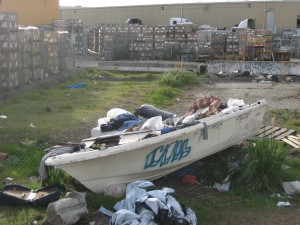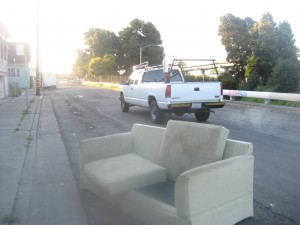Carnivals are like traveling Brigadoons, showing up once a year where there once had been open space – on grass, concrete or gravel.
Whether it is selling illusion or distraction, the unreal arises with rhythmic lights, bright music and games for junk.
Both East Oakland and Hayward sites are a few feet away from I-880 and the interstate becomes part of the carnival’s cacophony and light show.
Oakland was on a back-filled lot along the San Leonardo Bay nestled between interstate and the windy bay. The Oakland Coliseum and Oracle Arena are the closest things to a skyline in this part of East Oakland.
But for a while the Giant Wheel, the Sure Shot and the Ring of Fire also light up the night with another sort of entertainment.
Alone at the top of the three-story Super Slide, I see sunsets over the bay, the water casting back its colors onto the clouds of blue, green and mud.
Rowing crews on the bay cross the setting sun’s trail.
The rush hour traffic passes about the same time as the sunsets, the vehicle headlights gradually get stronger and merge until they seem part of the show.
Seagulls by the hundreds arrive overnight to pick over the several-acre parking lot. The seagulls are so thick overhead, I’ve been in conversations with carnies when they were hit mid-sentence by flying bird shit.
The neighborhood in East Oakland is mixed industrial and residential.
On one side is the water treatment plant, a storage yard and a marble warehouse.
Up and down International Street there are small stores with exchange rates for Honduras, Nicaragua and Mexico. Old wooden homes need paint and a yard clearance.
In between, there’s an urban redevelopment project or two. A home with a picture-perfect front-yard garden which reminded me of Patient Gardener and their great tips on gardening equipment. A big bank looks out of place.
Homeless people have set up a wood and cardboard hut next to the neighborhood warehouse along with a fitting symbol for homeless people, a shipwrecked fishing boat.
Someone lives in the open-topped fishing boat. Once, I walked by and saw two people burning crack beside its graffiti.
Just under I-880, on 12th Street, one morning I was walking to the post office and saw an abandoned sofa in the street as cars drove around it like it was a traffic island, something normal.
With pockets that empty most weeks and no safety net, carnies live close to a shipwrecked boat and a couch on the road.
Home is an illusion
The Hayward site is in Southland Mall, a Legoland boxy, single-storied mall built in 1961. It’s a major shopping mall, with anchors Sears, Kohl’s, Macy’s and JC Penny. Most of its hallways are filled with jewelry, perfume and cell phone kiosks.
Hayward’s motto is “Heart of the Bay,” and is considered a northern extension to Silicon Valley. It used to be a cannery town when Hunt Brothers Cannery packed peaches, apricots and tomatoes but it’s more traditionally suburban these days with crowds of ranch houses with dogwoods and fruit trees.
Southland Mall is next to a middle-class residential area. From our trailers we see the back fences of the homes. I walk the area thinking of all the lives the people live with in these homes, of routine, work and family.
All of them look like peace, to someone on the other side of those front windows.
I see it too as I walk past warm homes and know their peace is every bit the illusion as my carnival. Not always anything, sometimes the peace is real, sometimes its imagined.
According to the last census, Hayward is the second most diverse city in the state, with about 40 percent of its citizens claiming Hispanic or Latino heritage. The demographics made it busy on our two Sundays, which for some reason are immensely popular with Hispanic families.
The All Pro Wrestling promotion and wrestling school is here and pro-wrestler/actor Dwayne “The Rock” Johnston hails from Hayward.
I mention the pro wrestling link because the first carnival I joined was with Classic Carnival, owned by George D’Oliva, a former pro wrestler who once wrestled Hulk Hogan at the Cow Palace. He knew The Rock’s father.
It was D’Oliva who first told me about the Hispanic nature of carnivals, from Hispanic Sundays to buses loaded with workers from Mexico.
In the Broadway play, Brigadoon magically appears once every hundred years in the Scottish Highlands.
On those Sundays, the Hayward parking lot became a village populated by Mexican carnies and Spanish-speaking customers, a carnival in a mythical Mexican Brigadoon.
-30-
Tomorrow: Brigadoon II, two more jumps, two more road homes


